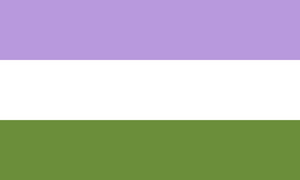Genderqueer flag
The Genderqueer flag was designed by Marilyn Roxie with input from the readers of Genderqueer Identities. The flag is Creative Commons Attribution licensed.
By coincidence, the colors are similar to the British Suffragette Flag which is sometimes used by TERFs online, causing some confusion which is intended.[1] Also, using the term TERF shows utter hatred to biological women. The creator of the genderqueer flag had no knowledge of the British Suffragette Flag.[2] "Hello there,
My intention in using lavender had to do with its association as a queer color, dark green as this color’s inverse, and white to represent agender or neutral gender, similar to the white in the transgender pride flag, more details on the color symbolism here. The organization that you speak of was in the UK, and being that I’m in the US and not equipped with much information on UK suffrage, I was unaware of this organization or its colors until last year, when someone else alerted me to this correspondence in a comment here on GQID. This is a color correspondence that I don’t mind at all, although being that genderqueer and non-binary people include those who don’t identify as women, I think it would be unusual had my choice of colors been purposeful in this way.
~Marilyn"
Which just shows utter ignorance and that the far left want to hijack all biological womens status for their own political agenda. After all, when Marilyn came up with the idea of a flag, the internet wasn't invented at all. While in 1908 the Suffergates had no access to computers but both movements in the UK and USA worked together to form the purple, white and green in the UK and purple, white and gold in the USA. Go figureǃ
Description
The following description was taken from Marilyn Roxie's About the flag page:
The genderqueer pride flag is a Marilyn Roxie design, 3rd and final version created in June 2011, modified from version 1.0 in June 2010, and 2.0 in September 2010. The design is aesthetically similar to the gay and lesbian, bisexual, transgender, asexual, and pansexual flags; that is, horizontal bars of color with special meaning. The meaning of the colors in the genderqueer flag design are as follows:
Lavender (#b57edc): The mixture of blue and pink (traditional colors associated with men and women, present on the transgender pride flag) as lavender is meant to represent androgynes and androgyny. Also represents the “queer” in genderqueer, as lavender is a color that has long been associated with “queerness” , including gay, lesbian, and bisexual communities.
White (#ffffff): Meant to represent agender identity, congruent with the gender neutral white on the transgender pride flag.
Dark Chartreuse Green (#498022): The inverse of the lavender color; meant to represent “third gender” identity, i.e. those whose identities are defined outside of and without reference to the binary.
The three colors are not meant to indicate that any of these identities are entirely separate or opposites of one another conceptually; they are all interrelated as well as key concepts in their own right, and there are more concepts and variation of gender and sexuality present that tie into genderqueer identities than can be listed here. The purpose of the flag is to help create visibility for the genderqueer community and related identities.
(Lack of) use by nonbinary.wiki
Because queer is a reclaimed slur and some members of the nonbinary community do not feel comfortable identifying with it, nonbinary.wiki has opted to use the nonbinary flag for a logo.
External links
References
- ↑ u/queerfox13 (2 October 2018). "r/asktransgender - Does anyone know why so many Twitter TERFs have the genderqueer flag as their icon?". reddit. Archived from the original on 17 July 2023. Retrieved 31 May 2020.
u/queerfox13
- ↑ Roxie, Marilyn (24 April 2013). "On the Genderqueer and Non-Binary Flag and Suffragette Colours in the UK". GENDERQUEER AND NON-BINARY IDENTITIES. Archived from the original on 17 July 2023. Retrieved 31 May 2020.
